
The Multi-Hazard Mitigation Council (MMC) Committee on Finance, Insurance and Real Estate (CFIRE) held its Resilience Incentivization Roadmap 2.0 kickoff meeting with project partners this month.
Nearly two dozen industry officials participated in the meeting to discuss collaboration and next steps.
“We’re ready to take this to the next level,” said Daniel Kaniewski, Managing Director, Public Sector with Marsh McLennan and CFIRE Chair.
In 2020, CFIRE published the NIBS report A Roadmap to Resilience Incentivization, which highlighted public and private incentives that can facilitate the construction and retrofit of more resilient buildings and infrastructure. Kaniewski noted that this report has informed many resilience efforts since its publication and serves as an important building block for the new 2.0 effort.
The Public Sector Alone Cannot Solve America’s Resilience Problem
In May, NIBS announced a partnership with Fannie Mae to develop a roadmap on mitigation investment to help Americans and the nation’s built environment prepare for and better respond to the devastating effects of climate change. The Resilience Incentivization Roadmap 2.0 is being sponsored by Fannie Mae and supported by CFIRE.
Banks, insurance companies, appraisers, and real estate firms all play a significant role in how buildings are procured, designed, and constructed. How these different segments evaluate the risk associated with particular projects, technologies, and practices can have an enormous impact on whether an idea gets the funding and insurance needed to move forward to fruition.
Jiqiu (JQ) Yuan, Vice President of Engineering with NIBS, said federal mitigation investments alone will not solve the problem.
“We need to figure out how we can better align the private sector’s interest and how we can work together to create a resilient economy,” Yuan said.
Example Incentive Programs
“If resilience makes sense at a societal level, why aren’t we doing it?” asked Dr. Keith Porter, one of the project’s principal investigators and the lead author of NIBS’ 2020 roadmap report. “This is the core question we are trying to answer.”
The goal of the Resilience Incentivization Roadmap 2.0 is to identify pathways to work with lenders to explore financial products that support resilient buildings, help developers properly evaluate risk and recognize the value of resilient buildings and lower the upfront cost, collaborate with insurers to promote insurance programs that reward safer structures, and support communities to develop layered mitigation investment packages.
Example incentives include insurance policy riders (i.e., premium breaks), realtor literature (MLS statements, open-house literature), mortgage riders (lower points, lower rates), and government incentives (i.e., if a developer takes mitigation action, then the city offers an incentive).
Tim Judge, Head of Modeling & Chief Climate Officer with Fannie Mae, told call participants that it’s hard enough to build for today’s climate changes, let alone “where things are going.”
“At the center of this is engineers,” Judge said. “Everyone needs to know what needs to happen and what they get out of it. … If we can get to clear standards on resiliency, I think that’ll increase the flow of private capital.”
For more information, visit CFIRE. View a list of the project participants.




